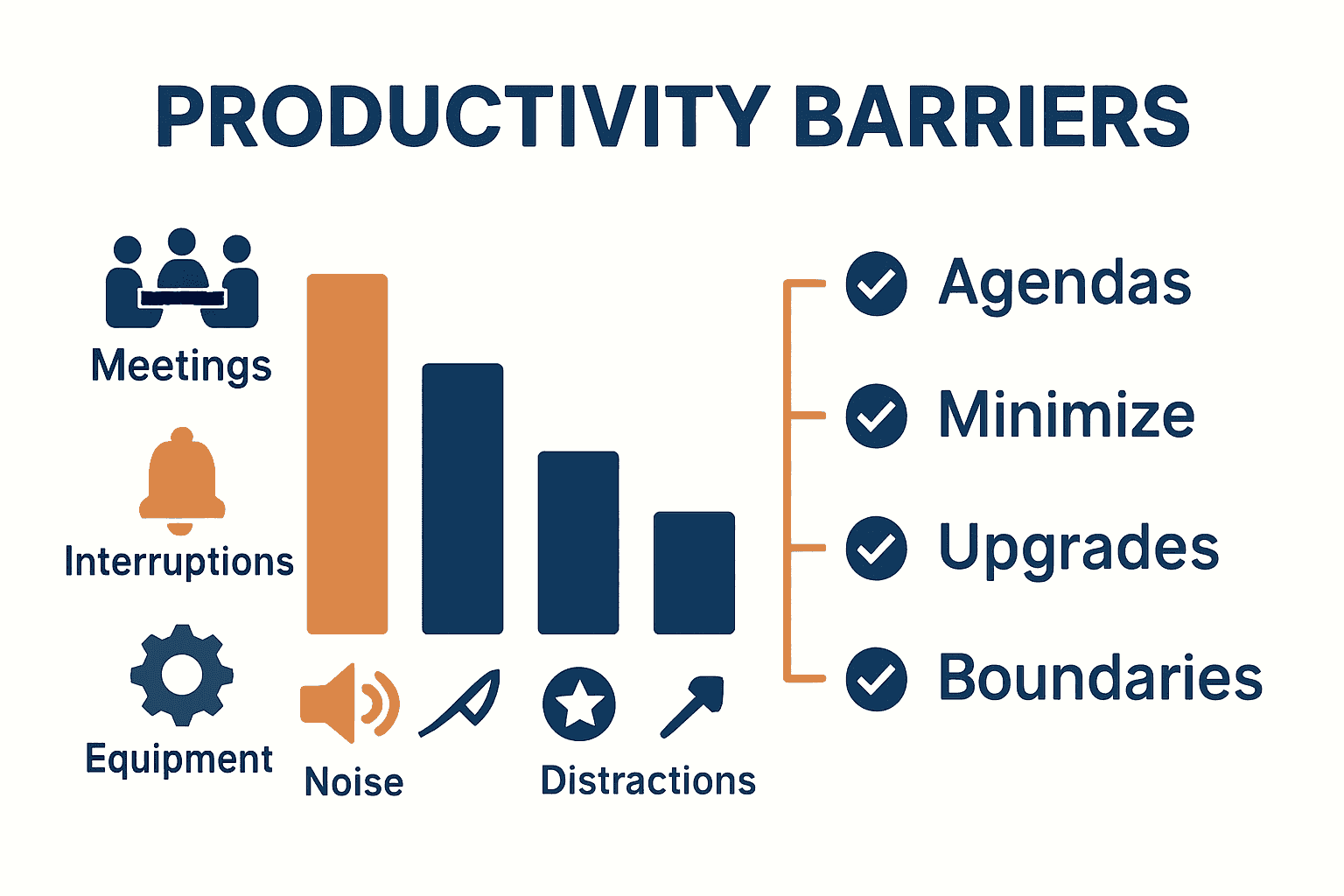Did you know that companies with high workplace productivity are nearly twice as profitable as their less efficient competitors? Productivity shapes how well a business turns resources into real results, and understanding what drives that efficiency is crucial for any organization aiming to thrive. From smart resource management to the latest technology and ergonomic solutions, businesses can unlock better performance by focusing on proven productivity strategies.
Table of Contents
- Defining Workplace Productivity For Businesses
- Key Types Of Productivity Strategies
- Tools And Technologies That Improve Output
- Role Of Floor Mats In Workplace Efficiency
- Common Productivity Barriers And How To Avoid Them
Key Takeaways
| Point | Details |
|---|---|
| Workplace Productivity Defined | Productivity is the efficient transformation of resources into meaningful outputs, focusing on smart workflows rather than longer hours. |
| Effective Productivity Strategies | Key strategies involve goal-setting, time management, and process streamlining to enhance employee output and minimize waste. |
| Technology Integration | Utilizing the right technological tools such as automation and collaboration software significantly boosts workplace efficiency and performance. |
| Addressing Barriers | Overcoming distractions and establishing clear performance metrics are essential for maintaining focus and enhancing overall productivity. |
Defining Workplace Productivity for Businesses
Workplace productivity represents the strategic measurement of how efficiently an organization converts its resources into meaningful work outputs. According to the U.S. Bureau of Labor Statistics, productivity fundamentally measures how organizations transform inputs like time, labor, and materials into valuable goods and services, providing crucial insights into economic performance.
At its core, workplace productivity transcends simple time tracking. It involves complex dynamics of resource management, prioritization, and adaptive goal-setting. Efficient businesses understand that productivity isn’t about working longer hours, but about creating smart workflows that maximize individual and collective performance. Organizations achieve this by implementing strategic planning, clear communication channels, and systems that support employee effectiveness.
Key elements of workplace productivity include:
- Clear performance metrics
- Efficient workflow design
- Technology that supports collaboration
- Continuous skills development
- Supportive workplace environments
For businesses looking to enhance their understanding of productivity practices, our guide on office productivity hacks offers practical strategies for transforming workplace performance. Research consistently demonstrates that organizations investing in systematic productivity improvement can significantly boost their operational efficiency and competitive advantage.
Key Types of Productivity Strategies
Productivity strategies encompass a range of systematic approaches designed to optimize workplace performance and efficiency. According to research from Marquette University, the most effective strategies focus on setting clear goals, implementing robust time management techniques, and streamlining organizational processes to maximize output and minimize wasted resources.
One critical approach involves goal-setting methodologies, particularly the SMART framework (Specific, Measurable, Achievable, Relevant, Time-bound). As highlighted by the Institute for Education Development, this technique helps employees create structured, actionable objectives that provide clear direction and motivation. By breaking down complex tasks into manageable components, organizations can dramatically improve individual and team productivity.
Key productivity strategy types include:
Here’s a comparison of popular productivity strategy types and their key focus areas:
| Strategy Type | Primary Focus | Example Techniques |
|---|---|---|
| Individual Performance Optimization | Personal output | SMART goals Pomodoro Technique |
| Process Streamlining | Workflow efficiency | Task automation Lean practices |
| Technology-Enabled Workflow Management | Digital tool integration | Project management apps Cloud collaboration |
| Time Management Techniques | Scheduling & priorities | Time blocking Urgency matrix |
| Continuous Learning and Skill Development | Skills improvement | Training programs Mentoring |
- Individual Performance Optimization
- Process Streamlining
- Technology-Enabled Workflow Management
- Time Management Techniques
- Continuous Learning and Skill Development
Some specific productivity techniques recommended by experts include:

- Pomodoro Technique (focused work intervals)
- Eliminating digital distractions
- Prioritizing tasks using urgency matrices
- Regular performance tracking and feedback
- Creating dedicated, interruption-free work zones
Our guide on sustainable workplace practices offers additional insights into developing comprehensive productivity strategies that support long-term organizational success.
Tools and Technologies That Improve Output
Modern workplace productivity hinges on strategic technological integration that streamlines workflows and eliminates operational bottlenecks. According to research from Coursera, providing employees with the right technological tools is crucial for enhancing workplace efficiency, as these technologies directly facilitate task completion and remove potential performance obstacles.
The landscape of productivity technologies encompasses a wide range of digital solutions designed to optimize organizational performance. Automation tools and real-time communication platforms have emerged as game-changers, enabling businesses to reduce manual processes and create more interconnected work environments. According to AFAEducation research, implementing these technologies can significantly boost productivity by creating seamless workflow mechanisms that minimize time-consuming manual interventions.
Key productivity technologies include:
- Project management platforms
- Cloud-based collaboration software
- Time tracking applications
- Communication and video conferencing tools
- Workflow automation systems
Practical considerations for technology implementation:
- Assess current workflow inefficiencies
- Select scalable, user-friendly tools
- Provide comprehensive employee training
- Regularly evaluate tool performance
- Remain open to technological adaptation
Our office productivity hacks guide offers deeper insights into selecting and implementing the most effective workplace technologies for sustainable organizational growth.
Role of Floor Mats in Workplace Efficiency
Workplace efficiency extends far beyond traditional productivity metrics, encompassing critical elements of employee comfort and physical well-being. According to the Occupational Safety and Health Administration (OSHA), ergonomic solutions play a pivotal role in reducing worker fatigue and enhancing overall workplace performance, with specialized floor mats emerging as a key intervention strategy.
The National Institute for Occupational Safety and Health (NIOSH) emphasizes that workplace ergonomics directly impact worker comfort and efficiency by minimizing physical strain. Strategically placed floor mats can significantly reduce the physiological stress experienced by employees who spend extended periods standing, particularly in manufacturing, retail, and service environments. These specialized mats create a cushioned surface that mitigates the impact of hard flooring, decreasing muscle fatigue and potential long-term musculoskeletal issues.
Key benefits of workplace floor mats include:
- Reducing physical strain on employees
- Minimizing workplace injury risks
- Improving overall worker comfort
- Enhancing productivity through ergonomic support
- Protecting flooring from wear and tear
Implementation strategies for floor mat ergonomics:
- Assess workplace standing areas
- Choose mats specific to work environment
- Rotate mat placement to optimize coverage
- Regularly maintain and replace worn mats
- Train employees on proper mat usage
Our comprehensive guide to floor safety mats provides deeper insights into selecting the right workplace mat solutions that support employee wellness and organizational efficiency.
Common Productivity Barriers and How to Avoid Them
Productivity challenges are universal across organizations, with research from Marquette University highlighting several critical barriers that consistently impede workplace performance. Workplace distractions represent the most significant obstacle, fragmenting employee focus and undermining strategic work objectives. These interruptions can range from digital notifications to frequent meetings and open-office environments that compromise concentration.
According to the Institute for Education Development, overcoming productivity barriers requires a systematic approach centered on goal-setting and intentional workflow management. The most effective strategies involve creating clear, measurable objectives, establishing dedicated focus periods, and implementing robust time management techniques that minimize potential disruptions and maintain consistent performance momentum.
Common productivity barriers include:
- Digital distractions and constant notifications
- Ineffective meeting structures
- Lack of clear performance expectations
- Poor time management skills
- Insufficient workplace ergonomics
Strategies to overcome productivity barriers:

- Implement strict digital notification management
- Create structured daily planning routines
- Establish clear performance metrics
- Design focused work intervals
- Minimize unnecessary meeting time
Our guide on office productivity hacks offers additional insights into developing robust strategies that help organizations and individuals navigate and overcome persistent workplace productivity challenges.
Boost Your Workplace Productivity with the Right Floor Mats
Struggling with employee fatigue and the hidden costs of discomfort in your workplace? The article highlights how ergonomic solutions like specialized floor mats can be a game changer for improving worker comfort and reducing physical strain. When employees feel better supported, productivity naturally rises. Don’t let tired and uncomfortable feet slow down your team’s efficiency.
Discover how floor safety mats from Mats4U.com can create a safer, more comfortable work environment that boosts focus and output. Our wide range includes Waterhog, Berber, Rubber, and Anti-Fatigue mats designed to meet the specific needs of your business. Benefit from mats that are made in the USA, competitively priced, and come with free delivery on orders over $100. Explore our solutions now and take the first step toward transforming workplace productivity by visiting Mats4U.com. Invest today in employee wellness and see immediate results in your business performance.
Frequently Asked Questions
What is workplace productivity and why is it important for businesses?
Workplace productivity measures how efficiently an organization transforms its resources into valuable outputs. It’s crucial for understanding economic performance and enhancing operational efficiency.
What are some key strategies for improving workplace productivity?
Effective strategies include setting clear goals using frameworks like SMART, streamlining processes, employing time management techniques, and fostering continuous learning and skill development.
How can technology enhance workplace productivity?
Technology, such as project management tools, cloud collaboration software, and automation systems, can streamline workflows, reduce manual tasks, and facilitate better communication among team members.
What role do floor mats play in improving workplace efficiency?
Specialized floor mats can enhance employee comfort by reducing physical strain, thereby minimizing injury risk and improving overall productivity in environments where employees stand for long periods.






